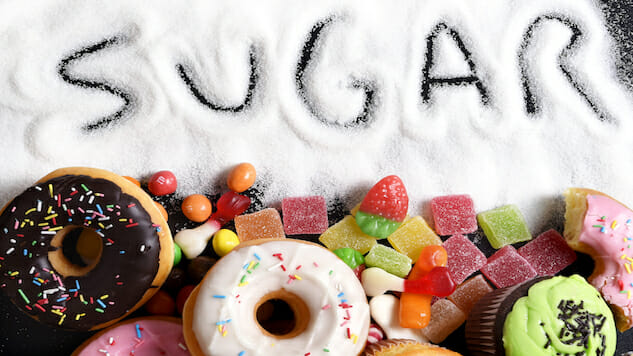This article is not meant to diagnose or provide medical advice—that responsibility lies with physicians. The author is not a licensed medical professional.
From Paleo to ketogenic and gluten-free, many diets now recommend reducing—or completely eliminating—sugar from your meal plan. And for good reason—excess sugar not only can lead to diseases such as Type 2 Diabetes, but also triggers fat storage.
“Added sugars have been refined and they get processed very easily by the body,” said Wesley Delbridge, a registered dietician and national representative for the Academy of Nutrition and Dietetics. “The easiest thing that the body does with an excess amount of sugar is convert it to fat. It’s actually a really efficient process.”
Cutting down on dessert is an obvious solution, but added sugars are everywhere—not just in cake, brownies and ice cream.
Here are some tips to identifying, and then scaling back on, the hidden sugars in your diet.
Avoid Not So Obvious Foods
Most processed foods are packed with added sugars, but there are a few surprising culprits that experts say to pay special attention to, including marinara sauce, flavored yogurt, granola bars, cereal, juice, sports drinks and coffee drinks.
“One problem with added sugars is that people don’t realize that they’re in so many things,” said Delbridge. Many energy bars also have sugar content similar to candy. “People say, ‘Oh, this has 20 grams of protein—I’m healthy now,’” Delbridge said. “But there’s a lot of sugar to make that 20 grams of whey protein taste good.”
But the No. 1 source of sugar for Americans is sweetened beverages, he said, which include obvious offenders like soda, and also sports and coffee drinks. “You think you’re drinking coffee, but they’re using heavy whipping cream and tons of added sugar to make that coffee taste good,” said Delbridge. “So be on the look out during your next Starbucks break—you may not realize how much sugar you’re consuming.”
Check Nutrition Labels
Delbridge urges you to check nutrition labels before buying processed foods. Next year the FDA will require packaged foods to include a separate line for added sugars. Until then, all sugars—naturally occurring and added—are lumped together, making it difficult to understand exactly what’s in a product. So Delbridge has a general rule: “if you see double-digit grams on sugars, that’s probably not a good food,” he said.
It’s also important to check the ingredients, said Diane Sanfilippo, a certified nutrition consultant and author of The 21-Day Sugar Detox. Ingredients are listed from most prevalent to least, so if a sweetener is near the top, it may not be the best option. But be careful, she said, as “there’s a huge, long list of different names that sugar can have,” she said, including syrup, honey, agave, nectar, concentrated juice, juice crystals and high-fructose corn syrup. By listing different types of sweeteners, food companies can make their products appear as if they have less sugar—so be sure to read through the entire ingredients list.
Prepare Food at Home
Sanfilippo agrees that cooking is the best way to avoid sugar-loaded processed foods—and to ensure complete control over what goes on your plate. “That doesn’t mean every meal has to be an epic endeavor. It could be something as simple as turkey over a salad with some olive oil and lemon juice.”
Amy Green, author of Simply Sugar and Gluten-Free, said that instead of cereal for breakfast, try oatmeal, cream of buckwheat or eggs. Instead of flavored yogurt, put frozen fruit in the bottom of a mason jar, sprinkle with cinnamon, oats and chopped nuts and top with plain Greek yogurt. Replace jarred marinara sauce with your own recipe of crushed tomatoes, spices and a pinch of cinnamon. And swap bottled salad dressing for balsamic vinegar mixed with olive oil. “Start with the food you know and love,” said Green. “Do it so it’s manageable.”
Grab Fruit Instead
While whole, fresh fruit is loaded with sugar, it also comes with fiber, vitamins and minerals, which make it a healthy alternative to cookies, said Delbridge. The fiber in a piece of fruit slows the absorption of sugar and also keeps the body feeling full longer, he explained. But be careful of fruit juice. Many brands contain added sugar, and even 100 percent fruit juice is not as healthy as eating a piece of fruit. “You’re losing the pulp, you’re losing some nutrients, you’re losing the fiber and you’re losing the activity of eating the whole piece of fruit—which takes a lot longer than guzzling down a cup of apple juice,” said Delbridge. “Apple juice is so refined now that nothing really reflects apples anymore.”
If you’re looking for a fruity beverage, Sanfilippo suggested smoothies—made at home. “Don’t get it from somewhere, because they’re going to add sugar to it,” she said. “Use strawberries and coconut milk or almond milk, and you can make it a lot healthier.”
Avoid Artificial Sweeteners
Even though many artificial sweeteners are calorie- and sugar-free, they’re not necessarily a healthy alternative. A 2014 article in the journal Nature showed that artificial sweeteners can still increase the risk of pre-diabetes. They also don’t help to reduce calories according to Delbridge. “A lot of research shows that if you lose 200 calories because you went with an artificial sweetener, you’ll find 150 calories somewhere else,” he said. Moreover, artificial sweeteners shape your palate the same way sugar does, said Sanfilippo. “Having that sweet taste all day long, especially if you drink diet soda a lot, just sets you up to want that more and more,” she said.
Caitlin Yoshiko Kandil is a journalist based in Southern California who covers social issues, culture, food and health.
